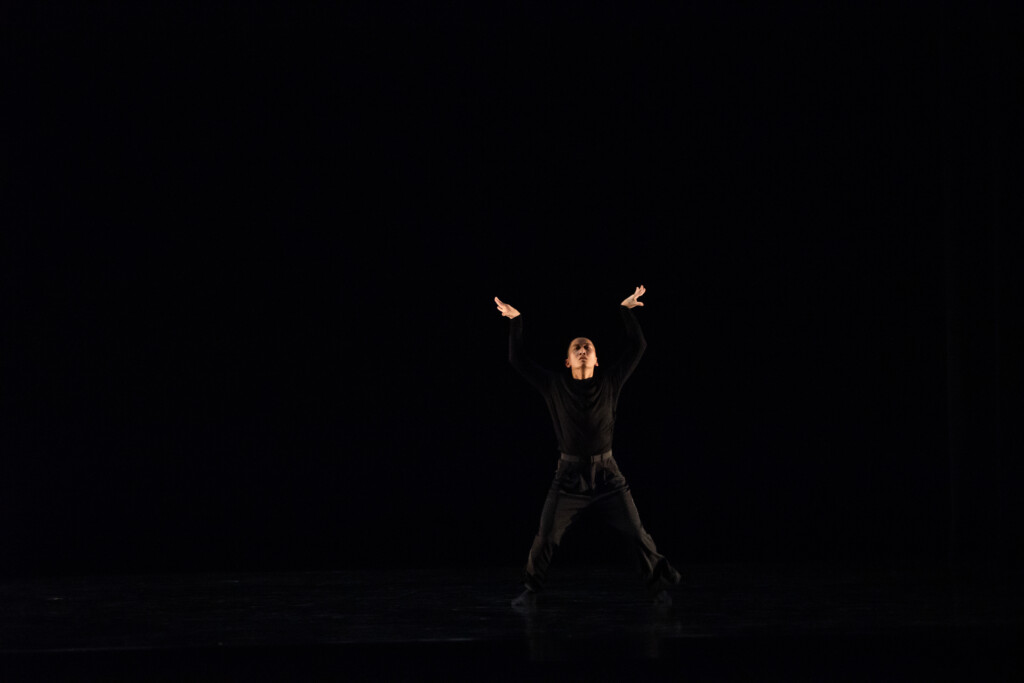In 2021, when the Repertory Dance Theatre (RDT) premiered Ihsan Rustem’s ebullient Hallelujah Junction, it was the evening program’s closing work and it drew a rousing roar of applause from the audience.
Last week, Hallelujah Junction opened RDT’s Gamut show, a performance that immediately guaranteed a record mark was about to be set for a spectacular emotion-packed evening. Gamut represented one of the greatest dance productions this critic has seen on the RDT company stage, over the last 17 years.
Rustem’s work, in which the dancers turn the stage into a choreographic playground, typically belongs at the end of a program, due to its incredible physical demand on the dancers’ stamina. But, with a world premiere scheduled to close out Gamut and the company’s 58th season, the decision to place this supernova burst of dance energy at the front turned out to be a brilliant move.
Rustem had returned several months ago to tweak the choreography, which sharpened Hallelujah Junction’s bite and further magnified the personalities of the eight company dancers who performed it. The work opens with a rapid-fire succession of solos featuring each of the dancers before morphing into a masterful exhibition of partnering and coupling. Rustem’s intuitive grasp of John Adams’ music by the same title (which the composer used as the title of his published autobiography) shines in its interpretive impact of the score’s sonic landscapes. Rustem was first drawn to the Adams score, when he danced in the 2003 work Guide to Strange Places by choreographer Peter Martins, which had included a section featuring a live performance by two pianists.
The RDT dancers (Caleb Daly, Trung “Daniel” Do, Lindsey Faber, Jonathan Kim, Jacob Lewis, Megan O’Brien, Ursula Perry and Caitlyn Richter) were outstanding in extracting the mesmerizing luminosity and ecstasy in Rustem’s movement language. It matched perfectly with the swings and transitions in Adams’ music, an ideal canvas for choreography.
After a brief pause, the eight RDT dancers, who were joined by guest artists Bashaun Williams and Kara Komarnitsky, returned to perform Lar Lubovitch’s Marimba, which was created in the 1970s in the midst of minimalist music’s greatest visibility. Lubovitch is a legendary choreographer who was among the earliest prominent dance figures to set works to new music by great minimalist composers such as Steve Reich, Terry Riley, Philip Glass and others. Katarzyna Skarpetowska returned as Lubovitch’s répétiteur to re-stage the work.
As Skarpetowska explained in a video shown prior to the performance, the movement language in Marimba is straight forward, elemental and easy to learn. But, to execute it in sync with what many have considered to be among Reich’s finest pieces of music (Music for Mallet Instruments, Voices and Organ, 1973), the dancers must capture the effect of the score’s long melodic lines, cast against jazz-influenced buoyancy that pops continuously with layered rhythmic textures and tones that sometimes remind of ghostly apparitions. As required in the music, the dancers find the proper group intuition in their movement that emulates the hocketing effect of Reich’s score. For this creative brief, the dancers succeeded in stellar fashion.
As for the closer, Solfège, the world premiere of Yusha-Marie Sorzano’s first commission for RDT, was wow, wow and wow, with the company in superb moments and an ending that was stupendous in its emotional impact. The closing night performance of Solfège triggered that rare sensation of goosebumps for this critic.
It is dance theater par excellence. As with Rustem and Lubovitch, Sorzano is a choreographer with an extraordinary intuitive grasp of the music she selected. In this case, it is Tan Dun’s 2011 Symphonic Poem of Three Notes. While the score certainly stands on its own merit for listening, Sorzano extends its emotional capacity, precisely in line with choreographed movement. Solfège telegraphs our fascination with the cycles of the natural world, which are intertwined with sirens and otherworldly figures, which are reminiscent of the characters in Guillermo del Toro’s film Pan’s Labyrinth.
The dancers gave Sorzano’s choreography its full cinematic effect, performing in a natural-fantasy world, starting from its primordial roots and building to its greatest burst of drama and cacophony of industry and finally returning to its primordial home.
And, then there was the final moment: soloist Jon Kim, who is leaving the company after five years to pursue new artistic ventures. Kim returns us to the primordial roots which opened Solfège. Even without the unique circumstances that this was Kim’s final performance on the RDT stage, it was a stunning moment. This was as fine a dramatic ending as anyone could have imagined: Kim, standing as the lights darken; his presence reminding us of the selfless dedication along with the compassion and conscientious sensitivity he has shared with his peers and with the dance community during his tenure. Its significance resonated with the absorbing narrative Sorzano crafted.
Collectively, the three works required imposing focus and physicality and the energy never flagged during Gamut. RDT dancers have consistently ratcheted up performance expectations.This is not an idle assertion, as two well respected former company dancers confided to me that they doubted that today they could audition successfully for a spot, given current expectations of skill and technique. As noted in The Utah Review’s Gamut preview, Sorzano, who works with dancers across the country and internationally, said she was impressed with RDT dancers’ fearlessness in exploring the possibilities of diverse movement vocabularies and the movement technique to express them effectively.
Gamut’s phenomenal artistic success has primed our anticipation for RDT’s 59th season.



